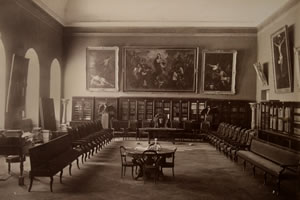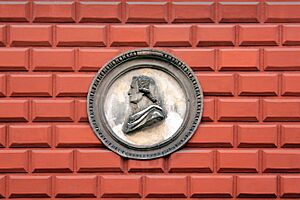Academy of San Carlos facts for kids
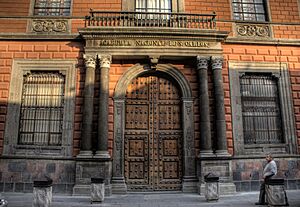
Main entrance, Academia Street
|
|
| Parent institution | Faculty of Arts and Design (UNAM) |
|---|---|
| Founder(s) | Charles III of Spain |
| Established | 1781 |
| Focus | Arts (graduate courses, mainly classical European traditional arts) |
| Formerly called | Academy of the Three Noble Arts of San Carlos: architecture, painting and sculpture of New Spain |
| Location | , |
| Coordinates | Lua error in Module:Coordinates at line 614: attempt to index field 'wikibase' (a nil value). |
| Website | https://academiasancarlos.unam.mx |
The Academy of San Carlos (Spanish: Academia de San Carlos) is a famous art school in Mexico City. It was once known as the National School of Fine Arts. This academy played a very important part in shaping Mexican art and architecture.
It was founded in 1781 as a school for engraving. This made it the first big art school and the first art museum in all of the Americas. About ten years later, the school moved to its current spot on Academia Street. This is just northeast of the Zócalo, Mexico City's main square.
For a long time, the academy taught art using the classical tradition from Europe. This meant focusing on ancient Greek and Roman styles. But in the early 1900s, it started to teach more modern art styles. Today, the Academy of San Carlos is part of the National Autonomous University of Mexico (UNAM). It is now called the Faculty of Arts and Design, with its main campus in Xochimilco. Only advanced art courses are still taught in the original academy building.
Contents
A Look Back: The Academy's History
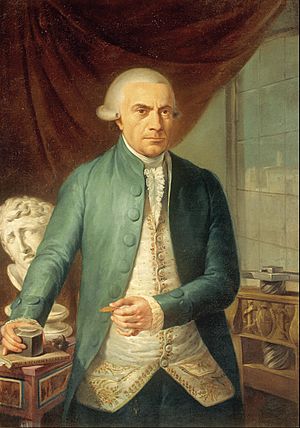
The Academy of San Carlos officially opened in 1783. It was the very first art academy in the Americas. It brought European teachers and bright students together. The building where the academy is now used to be a hospital. It was built in 1540 and was called "Hospital del Amor de Dios." This hospital closed in 1783.
In 1778, a famous engraver named Jerónimo Antonio Gil started an engraving school. He did this because the Spanish King asked him to. Gil and his friend Fernando José Mangino wanted to create a new academy. This new school would teach painting, sculpture, and architecture. Classes began in 1781 at the Real Casa de Moneda. Rich people, churches, and different states helped pay for it.
Founding and Early Years
Charles III of Spain chose Jerónimo Antonio Gil to be the school's first director. Gil brought together many talented artists of that time. These included José de Alcíbar, Santiago Sandoval, Juan Sáenz, Manuel Tolsá, and Rafael Ximeno y Planes. Tolsá and Ximeno later became directors themselves.
The new school promoted a style called Neoclassicism. This style focused on the art and buildings of ancient Greece and Rome. The academy wanted its artists to train in the European way. To help students learn, plaster copies of famous Greek and Roman statues were brought from Europe.
The official document to create the academy was signed on December 25, 1783. The viceroy Martín de Mayorga asked King Carlos III for this. They chose San Carlos as the school's special saint.
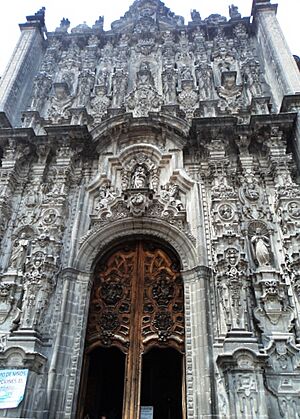
On November 4, 1785, classes officially began. In 1788, the Academy of San Fernando in Spain sent teachers. One of these was the famous Manuel Tolsá, who taught architecture and sculpture.
The academy wanted to grow a lot. They tried to build a new building designed by Tolsá. But it was too expensive. So, the academy asked for the old Hospital Amor de Dios building. They started holding classes there in 1787. From the start, the academy attracted the best artists in Mexico. It helped move Mexican art away from the old Baroque style, which was already out of fashion in Europe.
Changes Through the Years
In the early 1800s, the academy closed for a short time. This was because of the Mexican War of Independence. It also lost money from the Spanish royal family. When it reopened in the 1820s, it was called the National Academy of San Carlos. The new Mexican government liked Neoclassicism. They thought the Baroque style reminded them too much of colonial times.
In 1844, the national lottery helped the academy. A third of the money collected went to buy and fix the building. This help ended in 1861 when Benito Juárez stopped the lottery. The academy then struggled for money.
During the Second Mexican Empire, the school was called the Imperial Academy of San Carlos. Emperor Maximilian I supported the arts and gave the school money. After the republic was restored, Benito Juárez made a law about public education. This law changed the academy into the National School of Fine Arts.
The school became part of the National University of Mexico in May 1910. It got back the name Academy of Fine Arts in 1913. A beautiful glass and iron dome was added to the courtyard. This created an art gallery protected from the weather. The parts for the dome were made in France and then shipped to Mexico.
The academy kept teaching classic, European art styles until 1913. That year, students and teachers went on strike. They wanted a more modern way of teaching art. This led to the director, Antonio Rivas Mercado, leaving. After joining UNAM, the academy still had a lot of freedom. In 1929, the architecture program became separate. In 1953, this department moved to the new UNAM campus. The painting, sculpture, and engraving programs were renamed the National School of Expressive Arts. Later, the undergraduate art programs moved to Xochimilco. Now, only some advanced art programs are still in the original Academy of San Carlos building.
In 2011, the glass and iron dome in the courtyard was repaired. Workers fixed problems like corrosion of the metal beams.
Famous Artists and Teachers
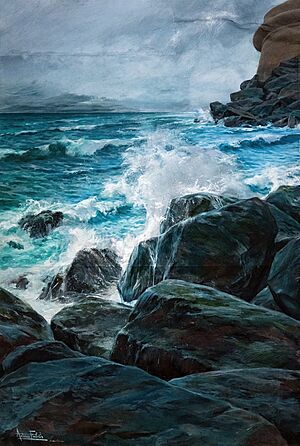
Many famous artists taught at the academy. Some of the first teachers included Miguel Constanzó for architecture, José Joaquín Fabregat for metal engraving, Rafael Ximeno y Planes for painting, and Manuel Tolsá for sculpture. Another important teacher was Pelegrí Clavé. He was known for painting portraits of heroes and figures from the Bible.
Catalan artist Antonio Fabres was very important at the Academy of San Carlos in the early 1900s. He taught many Mexican artists, including Saturnino Herrán, Roberto Montenegro, Diego Rivera, and José Clemente Orozco.
José María Velasco is thought to be one of the greatest artists from the academy. He was famous for his landscape paintings of the Valley of Mexico. He also taught Diego Rivera. Other artists connected to the academy include Manuel Rodríguez Lozano, Alfredo Zalce, Andrés José López, José Chávez Morado, Francisco Moreno Capdevila, Luis Sahagún Cortés, Gabriel Fernández Ledesma, Roberto de la Selva, and Jorge Figueroa Acosta. Matusha Corkidi, Elena Huerta Muzquiz, and Electa Arenal also studied there.
Architects from the Academy
Many important architects from the 1800s studied at the academy. Juan (born 1825) and Ramón Agea (born 1828) were sent to Rome by the academy. They studied with Cippolla and sent back drawings of Roman buildings. These drawings helped other students at the academy. They later became professors and worked as architects in Mexico City. They helped finish the Monument to Cuauhtémoc.
Another notable graduate was Manuel Francisco Álvarez (graduated 1863). He was an architect and a civil engineer. Álvarez was a city councilor and president of the Asociación de Ingenieros y Arquitectos. He also wrote many books about architecture.
The Academy Building
The building was first the Amor de Dios Hospital. When the engraving school moved there, founding director Gerónimo Antonio Gil oversaw its repair and redesign. Artist Javier Cavallari created the building's Neoclassic front. It has six special medallions. Four of these show the academy's founders: Carlos III, Carlos IV, Gerónimo Antonio Gil, and Fernando José Manguino. The other two show famous artists Michelangelo and Raphael. Cavallari also finished the courtyard, the meeting room, and the painting and sculpture galleries. The painting gallery has portraits by Ramon Sagredo, and the sculpture room has works by José Obregón and Manuel Ocaranza.
Many plaster copies of classic statues were brought from Spain for teaching. These copies are still there today. You can see them in the academy's main courtyard. Some of these include copies of statues from the Medici tombs, Moses by Michelangelo, the Winged Victory of Samothrace, and Venus de Milo.
Art Collection
The academy once had a very large art collection. It was called the Gallery of the San Carlos Academy. Many people consider it the first art museum in the Americas. The collection started with plaster copies of Greek, Roman, and European artworks. These were used to help students learn. The academy also collected European artworks like engravings from the 1500s to the 1800s. These came from Spain, France, England, Italy, Germany, and Holland.
The school also collected works from its students and teachers. Over time, the collection grew too big for the original building. It received gifts from private people and purchases from the Mexican government. The collection was then split up. Some pieces went to the Museo Universitario de la Academia. Others went to the National Museum of San Carlos. The rest stayed in the original building.
Works gallery
-
José María Velasco Gómez Self-portrait (1894). Velasco was a master of 19th-century Mexican landscape painting.
-
Vicente Guerrero painted around 1865, a portrait by Ramón Sagredo.
-
Incendiary Hidalgo, a mural honoring Miguel Hidalgo y Costilla in Guadalajara by José Clemente Orozco.
-
Fallen Idol by David Alfaro Siqueiros.
See also
 In Spanish: Academia de San Carlos para niños
In Spanish: Academia de San Carlos para niños
- Mexican muralism
- Mexican art


